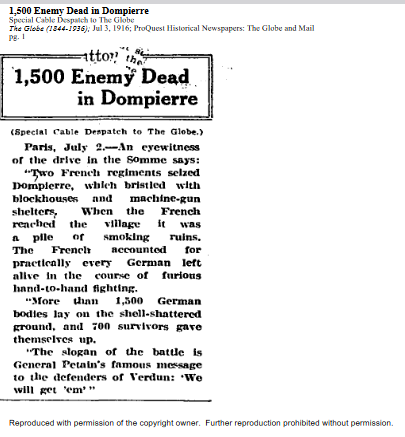This is essentially my comment in the news discussion expanded upon with specific examples/citations; mainly from The Globe, precursor to The Globe and Mail, in Toronto, Canada. I’m only going to be covering the allied side of this, since I don’t speak/read german and this is a lazy effortpost. First, an extremely brief rundown of the Somme that I’ve mostly gotten from wikipedia. It kicked off on July 1st, 1916 and would run about four and a half months, with the battle ending mid November. British casualties on the first day alone were 57,470 soldiers with 19,240 of those being killed or missing, and british casualties for the whole battle would total an estimated 420,000 with 95,675 being kia or mia. People have argued about why it happened in the first place, for the purpose of this I don’t care. When the battle had ended the allies had advanced about 10 km (~6 miles) on a 26 km (~16 miles) front. It was during the battle of the somme that tanks would be used in battle for the first time, but that was in mid september so I might visit that in another post.
Here’s a map of the battlefield stolen from wikipedia, note the locations of the villages mentioned further down.
Let’s start off with the front page column titled WAR SUMMARY from the July 3rd edition of The Globe. I’ll cover a few points of interest. The article starts off talking of “notable progress” being made on a 25 mile front, but it being too soon to talk of the exact extent of territory occupied or losses inflicted on either side. The british and french have captured the villages of Fricourt and Frise respectively . German resistance is described as “stubborn” but the allied progress is “satisfactory”. Sir Douglas Haig, the commander of the british forces, said the “general situation might be regarded as favorable”. The article goes on to say it is impossible to get an estimate of either side’s casualties, but as an aside reports 1,500 german dead found in a single village. The seventh paragraph is of particular note, stating “It would be unreasonable to speak of the operations now in progress as the great offensive of the Allies. The writer of the War Summary believes that it will be found to have been a preliminary tryout, and that a similar breach on a wider front is likely to be made in the Lille region…”. The article goes on about the other theatres of war but I’m focusing on the Somme so i’ll end it there. There’s a few points I want to make here. First of all let’s find the villages of Fricourt and Frise on that map. I’ll give you a hint, they’re right next to the July 1 starting line, barely a mile into german lines. We’ll come back to them later, keep them in mind. Then there’s the incredibly nebulous statement from Haig, who’s response to almost 20,000 dead in a day was “might be regarded as favourable”. There’s also the tendency to shy away from exact numbers of casualties, except when talking about German casualties.



The next article is also from the July 3rd edition of The Globe, titled 1,500 Enemy Dead in Dompierre. It’s a short blurb about the french capturing Dompierre (look on the map, again it’s barely off the front line), killing 1500 german troops and capturing 700 more. Absolutely no mention of how many casualties the french took, and it ends with a rousing line from Petain “We will get ‘em”

Next is another front page column, BULLETINS OF VICTORY, again from the July 3rd edition of The Globe. It covers all the fronts but again I’ll focus on the somme. There are further descriptions of the heavy fighting on the somme, again mentioning Fricourt and another village La Boiselle (again less than a mile from the starting lines). More prisoners taken, more trenches captured, and reports of german casualties being revised because initial estimates were too low (hmm). Under the sub header “enemy losses are heavy” they have this quote “the large number of enemy dead on the battlefield indicates that the german casualties have been very severe, especially in the vicinity of Fricourt”. Still absolutely no mention of allied losses beyond vague acknowledgements. It ends with the official report from Berlin, which funnily enough seems to be closer to reality as we understand it today. It reads in part: “From Gommecourt to the region of La Boiselle, the enemy obtained no advantages worthy of mention. He sustained, however, very heavy losses. On the other hand, he was successful in penetratin at several points the first line trenches of our division in the region abutting both banks of the somme, and was able to advance. This division had to be withdrawn from the heavily shelled first line trenches into the positions arranged for checking the advance from the first to the second line. The material in the first line which was immovable, and which was rendered useless, as is customary in such cases, has been lost” This is interesting. While the allies have been reporting victories in capturing these villages and penetrating the lines, the germans are simply following a defence in depth strategy that can easily cope with the loss of the first line, and is prepared for that eventuality.

This next article is going to be the last for tonight, I’m not giving it the attention it deserves because I’m tired and have other stuff to do. Without further ado, from the same source as the rest, BRITISH AND FRENCH SMASH FOE TAKE 9,500 MEN. Under the subheader Murderous Machine Guns, it talks about british troops being forced to “retire” under machinegun fire, while germans are “mowed down” by the same weapon. The difference in turn of phrase stuck out to me. The article continues with tales of heroism, increasing gains, more mentions of Fricourt and La Boiselle, and of german prisoners looking like shit. Then there are descriptions of british wounded returning to casualty clearing stations. I’ll quote the article- “many were slightly wounded in their hands and feet. They were wonderful in their gaiety and courage, all grinning as though just come from a “jolly” in which they had been bumped a little”. In general the reporting really tones down the horrors of war and emphasise enemy casualties and the heroic adventure that war supposedly is.
Edit: apparently I hit an image limit so I’ll post the rest later


It works in video games doesn’t it?